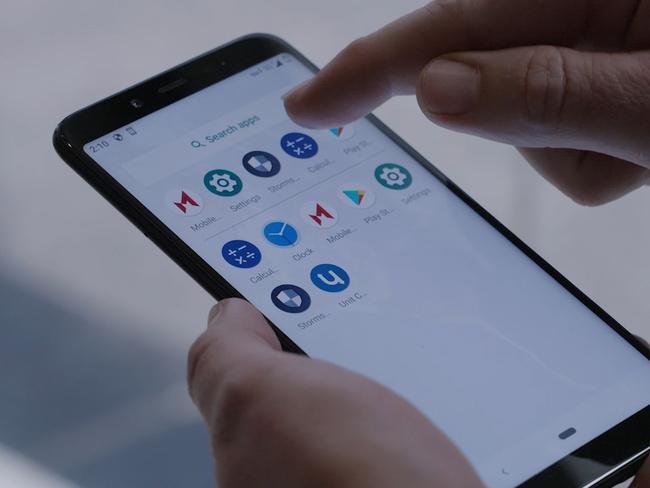Part 1: How Australian Federal Police and the FBI busted organised criminals on AN0M app
PART 1: This is how the AFP and FBI toppled Mafia, bikies and ethnic gangs from Asia to Albania by executing raids across Australia.
National
Don't miss out on the headlines from National. Followed categories will be added to My News.
Plotting the world’s most audacious take-down of organised crime required three essential skills: The ability to think like the most devious crook, the smarts to act like the savviest Silicon Valley tech wizard and the good nature to enjoy a beer after a long day at work.
When top-secret Operation Ironside erupted like a volcano into the underworld on Monday the untouchables of crime – Mafia, bikies and a host of ethnic gangs with masters from Asia to Albania – had a police squad the size of a country town burst through their doors across Australia.
They might have been arrested by tooled-up special operations officers brandishing military-style weapons. But they’d been outsmarted by the work of unassuming Australian Federal Police agents armed with an app and a big idea.
Ironside was a genius mix of imagination, nous and patience which started with a savvy AFP digital tech specialist known as The Operative and a relentless and energetic organised crime detective dubbed The Investigator.
Their police work was so devastatingly effective it will be written into crimefighting folklore – but without their real names.
Making prisoners – and fools – of the underworld brings with it enemies who are unlikely to forgive or forget.
THE OPERATIVE AND THE INVESTIGATOR
The clock started ticking on organised crime in Australia in May 2018.
The Operative, a clean cut everyman with world-class tech skills, and The Investigator, whose energy levels are matched only by his encyclopaedic knowledge of organised crime, were working side-by-side with the FBI to kill off Phantom Secure, a Canadian encrypted messaging app which criminals used to communicate safe from the eyes of police.
For Luddites, encryption simply means messages sent from one phone to another are turned into computer code for the journey and can’t be unscrambled by police taps. Encryption is the invisibility cloak which has allowed criminals to “go dark” and easily communicate out of reach of police since about 2010.
Just as the technological disruption of Uber brought the taxi industry to its knees by ruining its business model, encryption was a hammer blow to the way crime fighters did their business: The bad guys were now so much harder to catch.

But as The Operative and The Investigator downed a few beers with FBI agents at a bar thousands of kilometres from home, an idea started to take shape.
The two Aussies and their FBI counterparts were entitled to enjoy a few coldies – destroying Phantom Secure was a significant victory and had removed a vital tool used by organised crime.
But as the enormity of what they’d achieved in undermining some of the world’s biggest criminal networks sunk in, so did the realisation they could go much further.
“There was a gap in the market,’’ The Operative says now.
Criminals had grown to implicitly trust encrypted apps and after the take-down of Phantom Secure wanted an alternative.
What if a new encrypted device could be surreptitiously placed into the hands of criminals desperate for a new way to conduct their drug-trafficking and related nefarious business, the cops wondered?
And what if it wasn’t as secure as the crooks thought?
What if the encrypted messages could be decrypted and read in real time?


What if it gave crooks the security of distorting their voices on voice messages – but those voices could be unscrambled and identified?
And, most audaciously, what if law enforcement ran the platform and copied the messages as they were sent?
The Operative and The Investigator’s work meetings talking over these possibilities with FBI agents rolled seamlessly into drinks and dinner.
“That’s where this conversation started to snowball,’’ The Investigator says.
“We said, ‘we really think we can make this work’.”
The FBI already had a suitable device in the final stages of development and testing, known as AN0M.
But it was the Aussies who believed they could give it the magic – the technological ability to, in real time read, hear, and copy the messages as they were sent.
The pair returned to Australia and embarked on a plan so wildly ambitious and unorthodox it read like the makings of a movie script.
They were going to work with the FBI on a platform that looked just like any other encrypted device, but better. The FBI would set up a legitimate business to run it. Together, they would plant handsets fitted with a hidden encrypted message app, provide the website which ran it, and the servers to host it.

Their customers would be international drug traffickers, bikies, Mafia figures, Asian crime gangs and South American drug cartels. Then they would use the messages to bring them to justice.
The Operative has worked in accessing and monitoring criminal communications for law enforcement for 16 years, including five with the AFP. Being able to see behind the iron curtain of encrypted communications was the Holy Grail.
“It was a dream of all of us in law enforcement for the past decade,’’ the Operative says.
The Investigator believed the stranger-than-fiction plan could work.
“It was highly exciting but I knew that it was going to be a difficult journey,” he said.
“We had the best opportunity and no one else in the world had had it. So we were very keen to come back to Australia and sell that idea.’’
Neil Gaughan, then the AFP’s Assistant Commissioner of Organised Crime, enjoyed walking the floor of the force’s Canberra headquarters – it was often when his officers would pitch “ripping” innovations to try to win his backing.
One day the now-Deputy Commissioner Gaughan was buttonholed by The Investigator. “We have got this idea,’’ The Investigator said.

THE OBSTACLE BECOMES THE WAY
Ironside became so big and has resulted in so many arrests the AFP needed to call in reinforcements from as far afield as New Zealand to help out the more than 4,000 Aussie officers involved in its busts.
It will dominate courtrooms across Australia for years as a dizzying array of charges ranging from attempted murder to mass drug importations and money-laundering are prosecuted.
But in its early days it lived in a windowless bunker at the AFP headquarters, with The Operative, The Investigator, a superintendent named Rob Nelson who runs the force’s digital surveillance collection unit, and an inspirational quote.
The digital surveillance collection unit might sound like a mouthful – but it’s the left field, offbeat, no-holds barred ideas factory.
Supt Nelson describes his highly secretive unit as “the AFP’s answer to James Bond’s Q Branch” and says the team of 60 “happily wear the terms geek and nerd like a badge of honour”.
When The Investigator first pitched the idea Gaughan was intrigued, excited – and wary.
“I don’t mind taking calculated risks,’’ he says.
But he wanted time to think and to get some advice.

This was new territory: police would ostensibly be providing assistance to the criminals by giving them access to AN0M.
The Investigator and The Operative were keen for the green light and not afraid to push their case with the boss.
“The Investigator was bugging me from day one,’’ Gaughan says.
“He’s a pretty excitable young fella, I’ve known him since … before he joined the cops. He was very enthusiastic about the fact that there was this opportunity.
“I think for them it was pretty clear cut that we needed to take it.”
Gaughan wanted more information about the plan and told the pair to “cool your heels a bit, let’s think about it”.
“I asked them to go to do a fair bit of homework. This one was a good idea I thought, but I just needed to make sure.’’
Police were worried that clues to serious impending crimes such as murders could be picked up on AN0M, but be missed in the blizzard of communications.
“I was concerned … to ensure when the text messages started flying around that we had the ability to actually deal with ones that were threats to life, deal with the ones that were involved in drugs,’’ Gaughan says.

Artificial intelligence would need to be developed “to ensure that we actually didn’t miss opportunities” and “people didn’t die.’’
Police would later intercept and foil what they allege were least 20 threats to life, including five separate execution plots on two organised crime families, as well as a bikie planning the drive-by shooting of a rival.
While Gaughan was mulling the formal advice on the proposal, The Investigator and The Operative commandeered a large, windowless office at the bottom of the Edmund Barton Building – AFP Headquarters – in Canberra.
They called it the bunker, and along with their computers, brought in something a bit less hi-tech – a whiteboard.
To remind them of their mission, The Investigator wrote across the top a quote from the Roman Emperor Marcus Aurelius, whose ancient diaries had become a basis for modern-day stoic philosophy.
“The obstacle becomes the way,’’ it said.
The pair would treat encrypted communications not as a hurdle to their investigation of organised crime, but as an opportunity.

Police had been involved in a technical arms race with the underworld for years.
Encrypted platforms like Phantom Secure had given criminals the upper hand and left law enforcement “blind”.
“The competitive advantage we had with telecommunications intercepts, that was literally just taken away from us,’’ The Investigator says.
“That really tilted the field massively back in their favour.
“What we wanted to achieve was killing Phantom Secure and turning their ability to securely communicate in that way off overnight. An advanced objective which we didn’t achieve was – could there be a way for us to get to content?
“We used to say, ‘that’s the dream’. If you can see what they are communicating about then that wrestles that advantage back to law enforcement.’’
Just a few weeks later came the breakthrough they’d been waiting for.
Do you know more? Email us at crimeinvestigations@news.com.au
More Coverage
Originally published as Part 1: How Australian Federal Police and the FBI busted organised criminals on AN0M app





